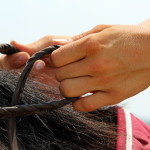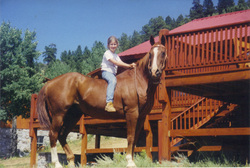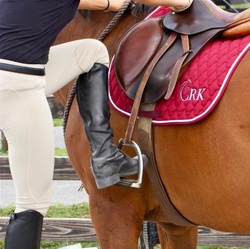Do you struggle with keeping your hands steady as you ride, and with being able to “feel” the reins and follow the horse’s movement with your hands?
Developing “independent aids” is one of the cornerstones of good riding, and “independent aids simply means that you can move one body part without everything else moving as well. Since our hands on the reins is one of the key ways we communicate to our horses when we are riding, it is quite important that we learn to keep them steady so that we can give clear signals to the horse and not create a lot of extra “noise” by moving them around too much.
Steadiness of the hands involves more than just our hands, however, as our whole body needs to be free from brace and unnecessary tension to allow our hands to be steady and to follow the horse. Our shoulders and elbows are key areas to focus on when when checking ourselves for brace and allowing a bit more movement so the hands can better feel the reins and follow the horse’s movement.
Another reason we need to have steady following hands is that, again, our hands can provide a great deal of communication with the horse. Rein cues or signals are better understood by the horse when they are clear and consistent, and when we take pressure on the reins, the release of that pressure says “yes, do that again” to whatever the horse was doing when the release occured. Unsteady hands can end up essentially saying “no, yes, no, yes” to the horse.
Developing good hands takes practice and is certainly more “feel” then theory. However, in today’s video I share an exercise that I have seen used by several of the trainers I have ridden with. I originally shot this video to answer a question from another reader, but then I decided to share it with you as well!
See you in the comments!
Callie














9 Responses
I will be trying that exercises thank you
Hi Callie,
thank you for your nice video and demonstration. I came across the way of holding the reins
you demonstrated so nicely many years ago as ” mexican or brasilian style “. It is interesting
and always worth a try for sure. I tried something else in order to stabilize my hands: I put
the reins through a not too light metal ring of about 6-7 cm diameter ( smooth reins of course ),
so that the reins are laying always flat on the neck and the influence and instability of the hand
is vastly diminished. Of course no receipt for always and ever. But try it just for fun or curiosity.
Probably you will be amazed, what this ring does and how happily your horse will accept it.
Good luck
Michael
Thanks for the strategy Michael, sounds like an interesting exercise!
Thanks! Exactly what I needed! I struggle with keeping my hands quiet even more in the sitting trot!
I’ve been waiting for a visit from an equine osteopath. Both of my horses were “off” and I thought they could use some work. My 17 year old gelding has numerous issues that I was suspicious of, but needed confirmation and to my dismay, she strongly recommended that he be retired from riding to keep him comfortable. I was going to retire my mare who is 23, but she is still capable of carrying a rider. She recommended that I continue to work with my gelding from the ground at the walk. Will you be doing any videos or do you have any recommendations for ground work exercises I can do with long reins?
Hi Mary Ann,
Thanks for your comment. I do quite a bit of in hand work with my horses, but most of it I just do at their shoulder with a halter or a bridle, so I really haven’t worked much with long reins. I did read a book that had quite a bit of long rein work in it, I just haven’t played with it yet. Here’s the link to the book: http://www.amazon.com/Horse-Training-In-Hand-Modern-Working/dp/1570764093/ref=sr_1_1?ie=UTF8&qid=1412796982&sr=8-1&keywords=work+in+hand+horses
Dear Callie,
Because soft hands are specially needed for riding a horse in a hackamore (for those who don’t know, this is a bitless bridle that applies pressure on the nose) I wanted to ask you about your technique with that bridle generally. The horse I ride is a riding school horse and though I’m not quite a novice I’m new to this particular challenge. It’s a mare who though she is very light on the forehand is very reluctant to go forward after the first ten minutes of schooling, and she’s absolutely resistant to squeezing, bumping, pricking with the dressage whip and so on. She has a reputation, bless her, for just dying on her riders, and I find it especially confusing not to have a contact with her mouth. There’s no sense that I can hold her on the outside rein, and she’s also very fidgety with her head. My instructor said: soft hands, longer rein. It didn’t help. All we could manage together was a smart walk. What I discovered though is if I halted her and asked her to take a few steps back, she tucked in her head, stepped smartly back and then immediately moved forward off the leg. Trot, canter – there was suddenly energy there and a will to do what was asked of her for the rest of the lesson. Any comments from you on any aspect of this story would be appreciated. I can’t understand the bridle or the behaviour, except to my delight the technique worked and we both went back to the stable happy.
Interesting question, Lesley, perhaps stepping back rebalanced her, which then made it easier for her to go forward? Or maybe she simply likes going back and being able to respond in that way made her more agreeable elsewhere. I’m kind of grasping at straws here, because I’m honestly not sure what could have made the difference for her after the backup, glad it helped though!
i have a ottb mare. my issue is that she needs a steady hand, but she head tosses so i cant have a steady hand..